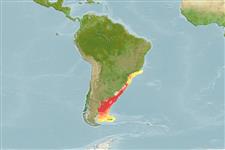Classificação / Names
Common names from other countries
Referência principal
Tamanho / Peso / Idade
Max length : 60.0 cm TL macho/indeterminado; (Ref. 7392)
Ambiente
; marinhas; estuarina bentopelágico; intervalo de profundidade 30 - ? m
Clima / Intervalo
Subtropical, preferred 15°C (Ref. 107945); 30°S - 47°S, 67°W - 50°W (Ref. 54258)
Distribuição
Descrição breve
Espinhos dorsais (total): 13; Raios dorsais moles (total): 15; Espinhos anais 3; Raios anais moles: 8
Categoria na Lista Vermelha da IUCN (Ref. 115185)
Ameaça para o homem
Harmless
Utilização humana
Pescarias: espécies comerciais
Mais informação
ReferênciasAquaculturaPerfil para aquaculturaEstirpesGenéticaFrequência dos alelosHereditariedadeDoençasProcessamentoMass conversion
ColaboradoresFotografiasStamps, CoinsSonsCiguateraVelocidadeTipo de nataçãoÁrea branquialOutras referênciasCérebrosVisão
Ferramentas
Relatórios especiais
Descarregue XML
Fontes da internet
Estimates of some properties based on models
Phylogenetic diversity index
PD50 = 0.5005 many relatives (e.g. carps) 0.5 - 2.0 few relatives (e.g. lungfishes)
Nível Trófico
4.0 ±0.71 se; Based on food items.
Resiliência
Médio, tempo mínimo de duplicação da população 1,4 - 4,4 anos (Assuming tm=2-4)
Vulnerabilidade
Moderate to high vulnerability (52 of 100)
Categoria de preço
